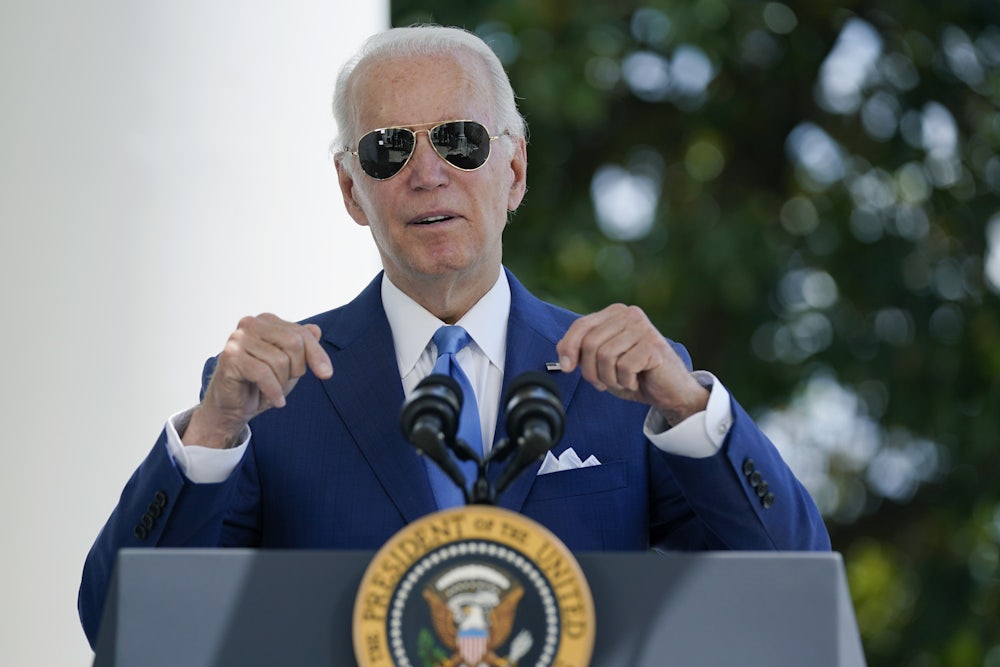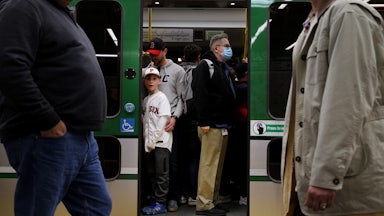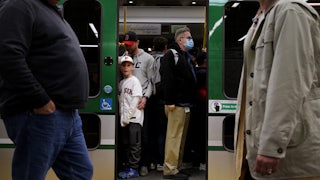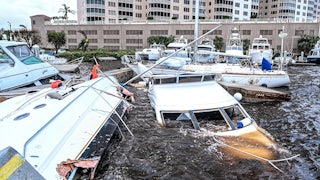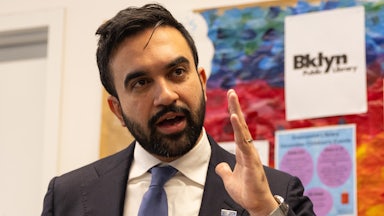The updated vaccines released in September were a marvel of science: the first time the shots to prevent Covid actually matched the variant circulating in our population. The first round of vaccines were based on the original strain identified in Wuhan, China, but by the time they rolled out, variants like alpha and delta dominated, which meant the vaccines were already out of date. Now the boosters updated to protect against BA.5, the predominant variant in the U.S., have the chance to be tremendously effective, especially at broadening our immune responses to future variants and lessening the risk of getting infected in the first place.
Yet days after the new vaccines began rolling out, President Biden told America on 60 Minutes that “the pandemic is over.” It was, from a messaging standpoint, the worst thing he could have possibly said.
In order to avoid—or at least mitigate—what’s likely to be another vicious winter wave, as many people need to get the updated boosters as possible. Now though, many people feel little urgency to do so—if they even know the new shots exist. The funds to continue keeping Americans safe from Covid—including vaccines, treatments, and tests—are dwindling or extinguished, and responding to Biden’s remarks, at least one congressional Republican announced that pandemic policies and funding need to be wound down rather than replenished. Who needs to end a pandemic that’s already done?
Since Biden’s declaration, more than 3,800 Americans have died from Covid-19. They and those who went before them are the only group for whom the pandemic is over.
Yes, we’re in a different place than we were in March 2020. Some parts are better: There are no refrigerator trucks stationed outside hospitals right now, we have incredibly safe and effective vaccines, we have learned how well high-quality masks and ventilation help prevent the spread of all respiratory illnesses. At a moral level, however, some parts are worse: We now know exactly what works to stop the spread, yet we’re not doing it. We know how to save lives, but hundreds of people continue dying every day.
“We have the tools, and now we’re setting up the entire system so that we cannot use those tools,” said Esther Choo, professor of emergency medicine at Oregon Health and Science University. “We just created this vacuum of information so that we can’t even pivot intelligently as the next surge comes.”
What’s actually “over” is the funding and sense of urgency for addressing the pandemic. If we continue on this path, “we’re not funding long Covid trials, wells are drying up for Covid relief funds, public health departments do not see an influx of a public health workforce that’s funded by Covid dollars, and we’re going to see no more Covid funding relief bills,” Josh Barocas, associate professor at the University of Colorado School of Medicine, told me. “We are now behind again.”
In June, the Biden administration reportedly discussed how many deaths from Covid are acceptable. That number appears to be more than 200,000 so far this year. One runs out of ways to describe such an intense wave of loss. That’s almost 500 jumbo jets crashing so far this year—almost two every day. It’s more than the entire population of Little Rock, Arkansas, or Salt Lake City, Utah, or Grand Rapids, Michigan. It is nearing half the population of Wyoming. And the year isn’t over yet.
The death tally doesn’t take into consideration the work and school hours lost from at least 40 million Covid cases—a number that is extremely undercounted—this year. It doesn’t account for those who go on to experience long-term symptoms—numbers that, shockingly, aren’t even tracked. If only 5 percent of people infected develop long Covid, that’s still two million people and counting who have a new chronic illness or disability in 2022. And the tally doesn’t include the mounting medical bills or the evictions or the missed births and graduations and weddings. It certainly doesn’t count the health workers being crushed under wave after wave of preventable cases and complications.
We seem, instead, to have decided that this is an acceptable rate of loss and disruption; this is our new normal. As soon as we leave the acute emergency phase, we believe the crisis has passed. But that means it’s only going to go on longer—and winter is coming.
Biden’s words weren’t surprising for anyone who has followed the administration’s approach to Covid. His chief medical adviser, Anthony Fauci, said we were exiting the “full blown” pandemic in February, as more than 2,500 Americans died from Covid every single day, and in April he said the U.S. was not currently in a “pandemic phase.”
“If they truly believe this,” said Barocas, referring to the Biden administration, “then I think that a lot of us were duped. He ran on Covid, he ran on science, he ran on listening to scientists.”
Even if the administration’s dismissal of the pandemic is a political move to gain momentum for the midterm elections, it will be difficult or impossible to walk back from the stance in a few months. “I just don’t see a way that [Biden can] then say, ‘Oh, no, no, guys. We were just kidding. We were just doing this politically,’” Barocas said. “We have to claw our way back after these sorts of comments, and it’s incredibly damaging to public health.”
Nationally, we are in the midst of a lull, with cases falling in dozens of states. Yet 15 states are seeing cases rise, and 10 states are seeing hospitalizations tick back up. Many of these states are in the Northeast, which has been a bellwether region for predicting new national surges. The United Kingdom, another coal-mine canary, is seeing the start of its winter Covid wave. Even if cases across the country continue flattening for the time being, experts are preparing for at least one winter surge. And they have their eyes on several concerning variants, such as BA.4.6, BQ.1.1, and BA.2.75.2, that could flourish in coming weeks.
“The more transmissible variants that are coming down the pike, the surge we’re seeing in the U.K.—all of this just feels like there’s so much potential to get bad and so much potential for us not to know that it has gotten bad until things are really devastating,” said Choo.
The virus hasn’t settled into a true, influenza-like seasonal pattern—summers still see significant surges—but the past three winters have brought the worst Covid spikes. As new variants evolve to be more immune-evasive, we expect to see a rise in cases. And we haven’t reached the point where a rise in cases is just an inconvenience: Hospitalizations and deaths still increase with each surge. And little is known about long Covid, which continues to devastate millions of Americans.
“That’s the thing about these massive case rates, with ‘milder’ disease, is that we’re completely missing the picture when it comes to long Covid,” said Choo. Long Covid is likely to be decreased with vaccination but not entirely—and vaccination rates are tanking too, leaving more people newly vulnerable to infections that linger. “There are a lot of people just stranded in the unknowns right now.”
At the same time that America’s health systems are preparing for another surge, the country is abandoning almost all of its funding and structures for dealing with Covid. Testing is inaccessible and more expensive than ever, now that public funding for PCR tests and the three-month price reduction for rapid tests expired. That means it’s impossible even to know how many cases we have—which in turn means we may not know we have a new surge until it’s already upon us. Researchers at the University of Washington, for instance, estimate that currently we are only detecting 4 to 5 percent of cases. Booster campaigns are flagging. The U.S. Centers for Disease Control and Prevention changed its recommendations so that staff and visitors in hospitals and nursing homes don’t need to wear masks unless cases are high, a move that will only make it more difficult for vulnerable people—older people; organ transplant recipients; cancer patients; those with kidney, heart, lung, or liver disease; people with disabilities; those with diabetes or obesity or immunodeficiencies; pregnant people—to receive the care they need. We are pushing to the edges of society those who need protection the most, and we are sickening and disabling those who don’t realize how serious this is until it’s too late or who realize it but are helpless to make the changes needed on a system-wide level.
Health workers too are overstretched, sick, scared of the winter surge, and contemplating leaving the field entirely. “Health care as a whole is so inaccessible right now,” Choo said. “We’re just begging people that we know to be very careful, to not get sick, to not need emergency care—which is something that we’ve said from time to time throughout the pandemic, but it’s now broken beyond recognition.”
Health workers say they have never known so many colleagues who are trying to leave medicine or take a break from clinical work. They are getting sick constantly and scrambling to cover shifts. “Every season we say it can’t get much worse in health care, and then we feel like it’s so much worse than the last season,” Choo said. “And I can’t imagine how bad another surge would be.”
Health care providers like Choo and Barocas fear that the Covid-is-over narrative will make these next waves worse. “I feel like Biden is unfortunately right—that there’s nothing I can say or do at this point to convince him, his administration, and the CDC that we are still in a public health emergency,” Barocas said. “I am unfortunately going into winter thinking, OK, well, I’m going to see some people dying, and I’m somewhat helpless to prevent that from happening.”
Barocas draws a distinction between health care emergencies and public health emergencies. The first one people have no trouble perceiving—think trucks lining up outside hospitals in early 2020. “Now it’s just a public health emergency,” Barocas said. That doesn’t make it any less pressing, he said—especially because one very often leads to the other.
But the U.S. has difficulty dealing proactively with health matters: “We refuse to put money into preventative care, we refuse to make preventative care a priority,” Barocas said. “The only time that something’s actually urgent is when you are literally dying. And it seems like right now the Biden administration is like, ‘Look, the country is not literally dying anymore, so we’re cool if we have to react instead of act proactively.’”
Covid spikes are like gunshot trauma incidents, he said. When a patient comes into the emergency room with a gunshot wound, a team of trauma surgeons, emergency room doctors, anesthesiologists, and nurses all assemble. “Everybody is there, and it is all hands on deck. It is a bloody mess, and they get to the ICU, and there’s thousands and thousands of dollars’ worth of resources going into saving this person’s life, which is appropriate,” he said. But “the other part of the emergency is that there were guns on the streets to begin with. Yes, we have the tools to save somebody’s life in that situation. But we haven’t put the resources into preventing the shooting to begin with.”
Here’s how to prevent these tragedies and end the pandemic for real: We should send more rapid tests to everyone for free, and free high-quality masks too. We should be expanding access to testing and treatment options and educating people about when symptoms appear and when they are contagious. Businesses and schools should be required to improve ventilation, with practical, understandable standards for air quality. We need paid sick leave and accessible, affordable health care. We should continue funding research on even more effective vaccines and treatments, and we should put immense resources toward understanding, preventing, and treating long Covid. We should be taking the bivalent and pediatric vaccines door to door. Masks should be required in all health care settings and on public transportation. These are all lessons we’ve already learned, that we already know work.
And all of this starts with effective communication about where we are, how we got here, and what we need to do next to continue making progress.
No one is asking the administration to adopt a pessimistic tone. On the contrary. But the administration ought to be able to talk about the progress we’ve made without undoing all of it, Choo said. “The conversation should be: Here are the really remarkable things about how far we’ve come scientifically—science has done really astonishing things, including provided some better diagnostics and therapeutics, better understanding of disease, better ability to detect variants and track things … here’s some good news, and then here’s some concerning things and things that could go wrong. And that’s why everybody needs to get a booster,” Choo said. “To the extent that we’re in a better place, we’re only there because there was massive public health effort along many fronts, including introducing people to vaccines and making it super accessible. In order to move forward, we need to continue to do that.”
